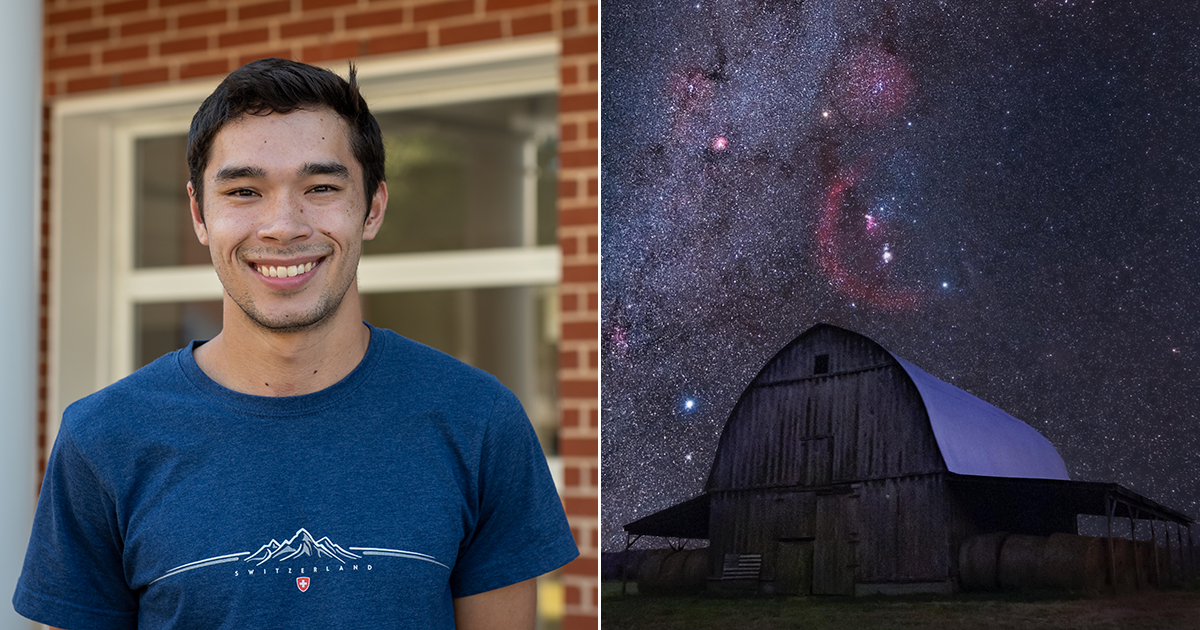[ad_1]
When Erik Stinnett is not in class or studying, he is spending time researching, teaching and mastering the art of astrophotography.
Stinnet, a senior computer science major, has been interested in astronomy for as long as he can remember. When he was in elementary school, Stinnett’s grandparents gifted him a motorized telescope, but it wasn’t until he was a freshman in college that he really started to learn about all its functions. One night he decided he wanted to take a photo of the moon using the camera on his mobile phone.
“I got my telescope out and put my phone up to the eyepiece and took a few pictures,” Stinnett said. “It wasn’t a very good image. It was blurry and out of focus, but I thought it was cool that I was able to do that. My interest grew from there.”

Erik Stinnett
Stinnet and his father began researching the kind of equipment they would need to capture images for both deep-sky and wide-field astrophotography. Deep-sky astrophotography involves capturing images beyond the Solar System like star clusters, nebulae and galaxies. It requires a special astronomy camera that connects to a telescope and computer. Wide-field astrophotography generally refers to images inside our solar system and can be shot using a digital single-lens reflex (DSLR) camera and a tripod.
“It was a long process of learning and figuring out how everything works together,” he said.
After a lot of trial and error, Stinnett captured a clear deep-sky image of the Orion Nebula one January night.
“It wasn’t as clear as some of my work now, but it was the first time I could make out something. I was super excited because it was the first time it worked,” he said.

Photo credit: Erik Stinnett
Stinnett kept shooting and improving. In 2020, one of his images placed 2nd in the 2020 Jewel Moore Nature Reserve Photo Contest. He won the 2022 contest with a panorama image of the Milky Way at Steel Creek.
This year, Stinnett and his classmates took an overnight trip to the Buffalo National River as a part of a Schedler Honors College course called “Nature’s Nation: Stewardship and Sustainability in Public Lands.” During a conversation with one of the park rangers, Stinnett mentioned his interest in astrophotography.
“She thought that was cool and asked me if I had any pictures of the night sky at the park. She wanted to use them to promote an appreciation of the night sky,” Stinnett said. The Buffalo National River has been intentional about decreasing its light footprint. In 2019, the park became the first place in Arkansas to receive an International Dark Sky Park Designation.

Photo Credit: Erik Stinnett
Stinnett sent some images and eventually became connected with Cassandra Johannson, a park ranger, who asked if he would do a wide-field photography workshop at Buffalo Point campground. About 20 people signed up for the first class.
“I started out with a presentation on what astrophotography is and how to shoot. Then for about two hours after that – until about midnight – we were out by the river taking photos.”
Stinnett has since gone back to the park to teach other workshops. Over fall break, he gave another presentation and led a workshop at Arkansas’ inaugural Dark Sky Festival at Tyler Bend campground. He shares his images on his Instagram account and plans to keep up his hobby of capturing the night sky.
“It is a challenging process to master, but it is certainly worth it,” Stinnett said.
[ad_2]
